Skull and Crossbones Symbol Meaning in OSHA Regulations
The skull and crossbones symbol, as defined by OSHA, serves as a crucial warning for highly toxic materials. This symbol is vital to OSHA's Hazard Communication Standard, appearing prominently on labels and safety data sheets.
It provides an immediate visual cue, alerting workers to the presence of acute toxicity and the need for extreme caution. Proper use and understanding of this symbol are essential for workplace safety and regulatory compliance.
OSHA mandates standardized labeling and thorough worker training to ensure employees are well-informed about chemical hazards and appropriate safety measures. To explore additional details related to OSHA's regulations and safety protocols, continue your research.
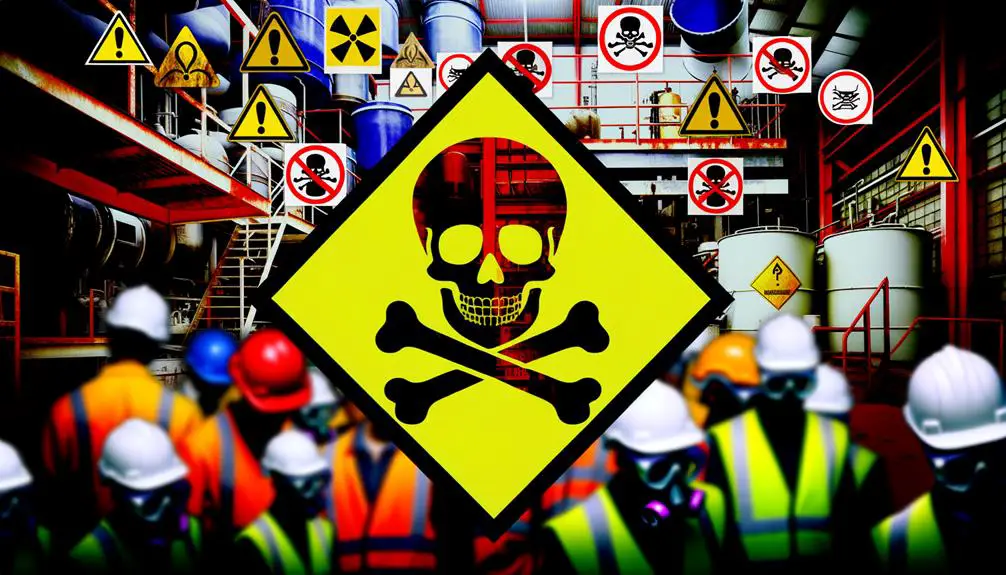
Key Takeaways
- The skull and crossbones symbol is used by OSHA to indicate highly toxic materials.
- It provides an immediate visual cue for extreme caution and acute toxicity.
- OSHA's Hazard Communication Standard mandates the symbol on labels and safety data sheets.
- The symbol ensures employees are aware of chemical hazards and necessary precautions.
- Employers must provide ongoing training on hazard symbols and emergency response.
Origins of the Skull and Crossbones

The Skull and Crossbones symbol, historically associated with piracy and danger, originates from medieval Europe where it was used to mark graveyards and signify death. This emblem, featuring a human skull above two crossed femurs, conveyed a stark warning of mortality and the impermanence of life.
Its utilization by the Knights Templar in the 12th century, combined with its adoption on tombstones, underscores its deep-rooted connection to death and the macabre. The symbol's stark, graphic nature made it an effective visual shorthand for danger and mortality.
Its evolution reflects a continual emphasis on its role as a dire warning, later evolving into various cultural and regulatory uses, including modern safety protocols established by organizations like OSHA.
Historical Uses of the Symbol
The skull and crossbones symbol has been historically employed in various contexts, including its notorious use on pirate flags to signify danger and intimidation.
Its adoption in the 19th century as a universal warning for poisonous substances also contributed to its recognition.
The symbol has also been present in military insignia to denote certain units or hazardous materials.
Each application reflects the symbol's potent ability to communicate threats and caution.
Understanding these historical uses provides essential context for its contemporary significance in safety regulations and standards.
Pirate Flag Significance
Historically, the skull and crossbones symbol, most famously emblazoned on pirate flags, served to instill fear and signal the deadly intent of pirates. This emblem, often referred to as the 'Jolly Roger,' was strategically employed to communicate a clear message to potential victims: immediate surrender or face lethal consequences.
The stark imagery of a skull and crossbones was deliberately chosen for its universal recognition and psychological impact, effectively deterring resistance and minimizing conflict. Pirates utilized this symbol as part of their psychological warfare tactics, often achieving their objectives without the need for combat.
The Jolly Roger played an essential role in pirate strategy, leveraging fear to enhance operational efficiency and secure plunder with minimal risk.
Poison Warning Origins
Derived from its macabre associations with death and danger, the skull and crossbones symbol has long been employed as a potent warning sign for poisonous substances.
Historically, the symbol's use as a poison warning dates back to the Middle Ages, where alchemists and apothecaries marked dangerous concoctions with this emblem.
Its utility was further solidified during the 19th century as industrialization increased the prevalence of hazardous chemicals. Regulatory bodies adopted the skull and crossbones to universally signify toxic substances, ensuring clear communication of danger regardless of language barriers.
This symbol's enduring presence highlights its effectiveness in conveying immediate threat, thereby preventing accidental poisonings and promoting safety in various environments.
Military Use History
Beyond its role in denoting poisonous substances, the skull and crossbones symbol has also been prominently utilized in military contexts, where it has signified various forms of danger and combat prowess throughout history.
Its military applications include:
- Pirate Flags (Jolly Roger): Utilized by pirates in the 18th century to intimidate and signal imminent danger.
- Military Insignia: Adopted by various military units to symbolize elite status and fearlessness, such as the German Totenkopf in World War II.
- Aviation Symbols: Used by fighter squadrons to denote lethal capability and combat readiness.
- Special Forces: Employed by special forces units to convey a sense of elite, high-risk operations.
These historical uses underscore the symbol's role in representing peril and valor in military contexts.
OSHA's Definition of the Symbol
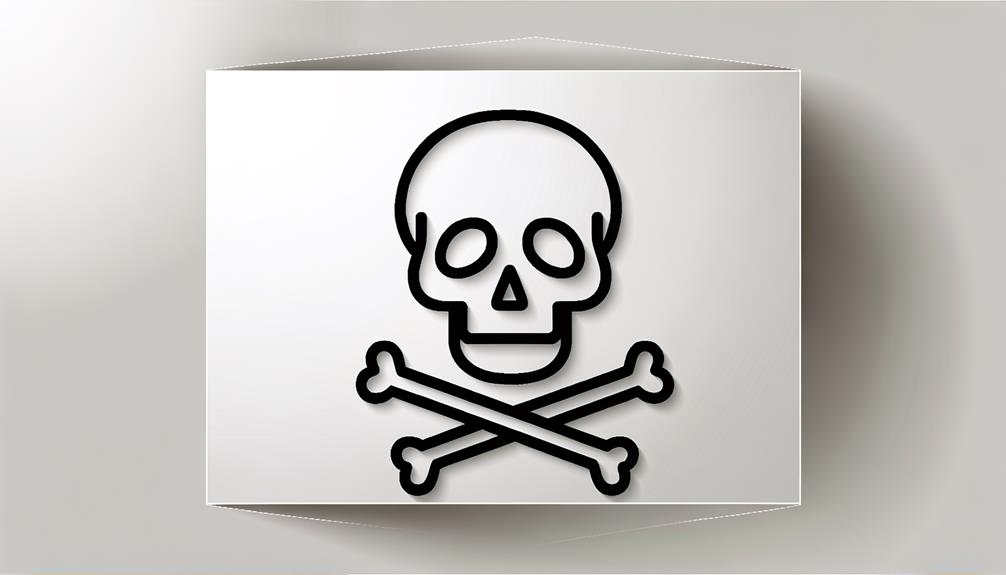
The Occupational Safety and Health Administration (OSHA) defines the skull and crossbones symbol as a warning sign indicating the presence of highly toxic materials that can cause severe health hazards or death.
This symbol is a critical component of OSHA's Hazard Communication Standard (HCS), guaranteeing that workers are aware of the dangers posed by certain substances. OSHA mandates that this symbol be prominently displayed on labels, safety data sheets (SDS), and other hazard communication materials. It serves as an immediate visual cue for workers to exercise extreme caution and implement appropriate safety measures.
The symbol's use is strictly regulated to prevent misuse and guarantee it conveys a consistent, universally understood message regarding potential lethal hazards.
Toxic Substances Identification
Identifying toxic substances is critical for maintaining workplace safety. This involves recognizing hazardous chemicals, proper labeling of these materials, and utilizing Safety Data Sheets (SDS).
OSHA mandates that all hazardous substances are clearly marked with appropriate warning symbols, including the skull and crossbones, to indicate acute toxicity.
Detailed SDS provide essential information on handling, storage, and emergency measures related to toxic chemicals.
Recognizing Toxic Chemicals
Recognizing toxic chemicals requires a thorough understanding of their distinct properties, hazard classifications, and appropriate labeling as mandated by OSHA. Proper identification is essential for maintaining workplace safety and ensuring regulatory compliance.
To effectively recognize toxic chemicals, consider the following:
- Chemical Composition: Analyze the chemical's molecular structure and reactivity to determine its potential hazards.
- Hazard Classification: Refer to OSHA's guidelines for categorizing chemicals based on their toxicity, flammability, and reactivity.
- Safety Data Sheets (SDS): Review the SDS provided by manufacturers for detailed information on handling, storage, and emergency measures.
- Physical and Health Hazards: Identify potential physical dangers such as corrosiveness and health risks including carcinogenicity or respiratory issues.
Understanding these aspects is crucial for mitigating risks and ensuring occupational health.
Labeling Hazardous Materials
Properly labeling hazardous materials is essential for effective toxic substances identification and compliance with OSHA standards. Clear labels guarantee workers can quickly recognize and handle hazardous substances safely. Labels must include the product identifier, signal word, hazard statement, pictograms, precautionary statements, and the name, address, and phone number of the manufacturer or importer.
| Component | Description |
|---|---|
| Product Identifier | Name or number for the chemical |
| Signal Word | Indicates the seriousness of the hazard (e.g., Danger, Warning) |
| Hazard Statement | Describes the nature and level of the hazard |
| Pictograms | Standardized icons indicating health, physical or environmental hazards |
Accurate and thorough labeling is crucial to preventing workplace accidents and ensuring regulatory compliance.
Safety Data Sheets (SDS)
Safety Data Sheets (SDS) are a vital component in the identification and management of toxic substances within the workplace. They provide crucial information regarding the properties, dangers, safe handling, and emergency measures related to chemicals.
Compliance with OSHA regulations mandates that SDS must be easily accessible to all employees. Key sections include:
- Identification: Details the substance name, manufacturer, and recommended use.
- Hazard Identification: Describes all potential health and safety risks.
- Composition/Information on Ingredients: Lists chemical components and associated concentrations.
- First-Aid Measures: Provides instructions for immediate medical attention in case of exposure.
These categories ensure that employees are well-informed and can respond appropriately to chemical hazards, fostering a safer workplace environment.
OSHA's Labeling Requirements
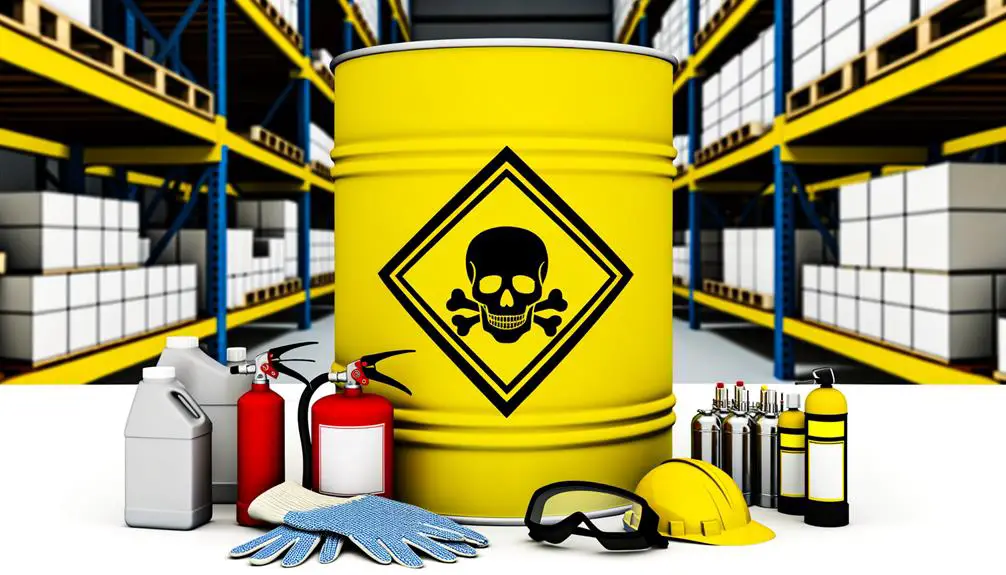
Adhering to OSHA's labeling requirements involves using standardized symbols and signal words to effectively communicate hazards. These requirements are designed to make sure that workers are immediately aware of potential dangers.
Labels must include specific elements:
product identifier,
signal word,
hazard statement,
pictograms,
precautionary statements, and
the name, address, and phone number of the manufacturer or responsible party.
The skull and crossbones symbol, for example, is used to denote acute toxicity, indicating that even brief exposure can result in severe health consequences. Signal words such as 'Danger' or 'Warning' are employed based on the severity of the hazard.
Safety Data Sheets (SDS)
Necessary for effective hazard communication, Safety Data Sheets (SDS) provide detailed information about the properties, health hazards, safe handling, and emergency control measures for chemicals used in the workplace. These documents are vital for ensuring workplace safety and compliance with OSHA regulations.
SDS are structured to deliver detailed data across multiple sections, including:
- Identification: Information on the chemical and supplier.
- Hazard(s) Identification: Classification of the chemical's risks.
- Composition/Information on Ingredients: Details on chemical constituents.
- First-Aid Measures: Immediate steps for exposure treatment.
SDS facilitate informed decision-making and proper safety practices by detailing necessary information. Compliance with OSHA's Hazard Communication Standard, which mandates the availability of SDS for all hazardous chemicals, is essential for maintaining a safe work environment.
Worker Training and Awareness
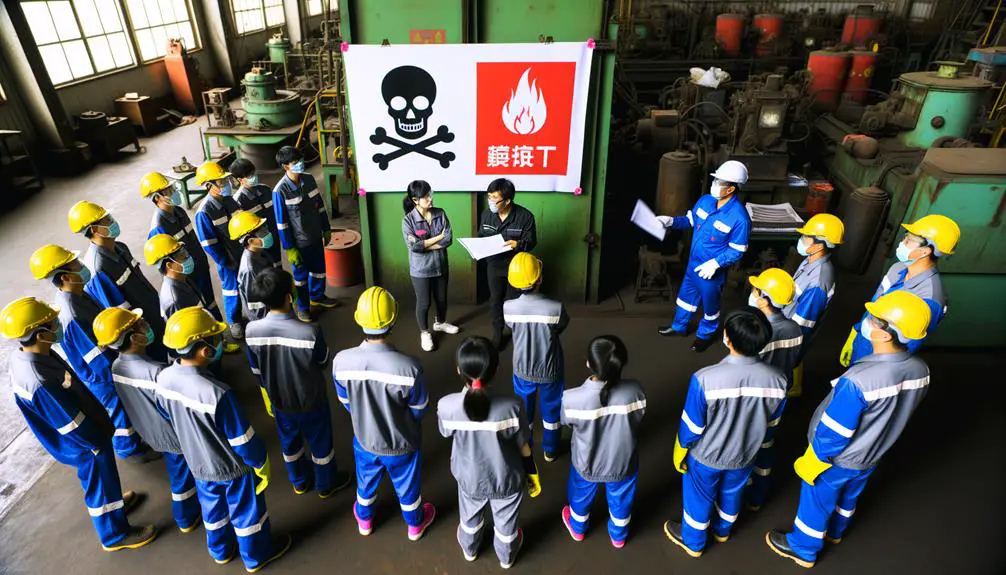
Effective worker training and awareness programs are crucial for ensuring employees grasp the dangers present in their work environment and the necessary precautions to mitigate them. These programs should include detailed instruction on interpreting hazard symbols, including the skull and crossbones, which signifies acute toxicity.
Training must cover the identification of hazardous substances, proper handling procedures, and emergency response protocols. Utilizing Safety Data Sheets (SDS) as a resource, workers can gain in-depth insights into the material hazards.
Employers are responsible for providing ongoing education, practical demonstrations, and assessments to confirm understanding. By fostering a culture of safety and vigilance, organizations can greatly reduce the risk of exposure to toxic substances and promote a safer workplace environment.
Compliance and Inspections
Maintaining compliance with OSHA regulations and conducting regular inspections are crucial for workplace safety and preventing exposure to hazardous substances. Compliance guarantees that all safety standards are met, thereby reducing risks associated with hazardous chemicals.
Inspections are vital for identifying potential hazards and making sure that corrective actions are implemented promptly. Key steps include:
- Regular Audits: Conducting frequent audits to verify adherence to OSHA standards.
- Hazard Identification: Methodically identifying and documenting potential risks in the workplace.
- Remedial Actions: Implementing necessary measures to address identified hazards.
- Documentation: Keeping detailed records of inspections, hazards, and corrective actions taken.
Following these steps ensures a safer working environment, aligning with OSHA's goal to protect worker health and safety.
Case Studies in Workplace Safety
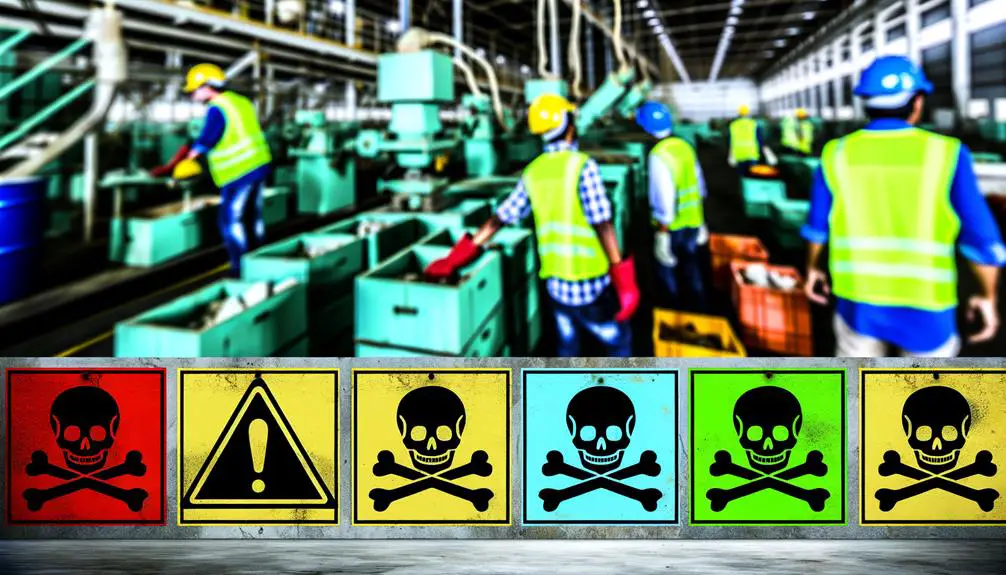
In examining case studies of workplace safety, we will analyze real-life incidents where the misuse or neglect of hazardous materials led to significant consequences. These case studies will highlight prevention strategies that could have mitigated risks and identify their subsequent impact on OSHA regulations.
Real-life Safety Incidents
How have real-life safety incidents in the workplace illustrated the critical importance of adhering to OSHA regulations, particularly those involving the skull and crossbones symbol? Several case studies highlight the dire consequences of negligence:
- Chemical Exposure Incident:
A factory worker was hospitalized after exposure to a mislabeled container of toxic chemicals.
- Laboratory Accident:
A lab technician suffered severe burns due to improper handling of a hazardous substance, despite clear skull and crossbones warnings.
- Waste Management Mishap:
Incorrect disposal of toxic waste led to environmental contamination and worker illness.
- Manufacturing Plant Hazard:
Failure to follow OSHA protocols resulted in a fatal incident involving highly toxic materials.
These incidents underscore the essential role of OSHA regulations in mitigating workplace hazards and protecting employee health.
Prevention Strategies Analyzed
Implementing strong prevention strategies is crucial for workplace safety. Case studies analyzing the effectiveness of OSHA-compliant protocols demonstrate the impact of such strategies. Effective strategies include hazard identification, employee training, and rigorous adherence to safety regulations.
For instance, a manufacturing plant that integrated detailed risk assessments and continuous safety drills significantly reduced hazardous incidents. Another case study from a chemical processing facility highlighted the benefits of real-time monitoring systems and proper labeling of dangerous substances, including the use of the skull and crossbones symbol to indicate toxic materials.
These measures not only safeguarded employees but also minimized operational disruptions. The correlation between proactive safety protocols and reduced workplace injuries underscores the importance of strict adherence to OSHA guidelines.
Impact on Regulations
Examining the impact of regulations on workplace safety through case studies reveals significant improvements in accident prevention and compliance. Notable examples highlight the effectiveness of OSHA's implementation of the skull and crossbones symbol to signify toxic hazards.
Key findings from these case studies include:
- Reduced Incidents: Facilities adhering to OSHA's guidelines saw a 30% reduction in toxic substance-related accidents.
- Enhanced Training: Mandatory safety training programs increased employee awareness and response efficacy by 45%.
- Improved Compliance: Regular inspections and audits guaranteed a compliance rate exceeding 90%.
- Cost Savings: Companies experienced a 25% decline in spill-related cleanup costs due to proactive safety measures.
These case studies underscore the critical role of regulatory frameworks in fostering safer work environments.
Best Practices for Hazard Communication
Effective hazard communication is critical in ensuring workplace safety and regulatory compliance. Adhering to OSHA guidelines involves several best practices.
First, employers must provide thorough training to workers about hazardous materials, including recognizing the skull and crossbones symbol, which indicates acute toxicity.
Second, Material Safety Data Sheets (MSDS) must be accessible and up-to-date, providing detailed information on handling, storage, and emergency measures.
Third, clear and consistent labeling of hazardous substances is essential. Labels should include hazard pictograms, signal words, and precautionary statements.
Additionally, incorporating periodic safety audits and employee feedback mechanisms can enhance communication effectiveness. By implementing these practices, organizations can mitigate risk, ensuring a safer work environment and adherence to regulatory standards.
Conclusion
To sum up, the skull and crossbones symbol, steeped in historical significance, now serves as a critical component in OSHA's hazard communication standards. By identifying toxic substances and mandating strict labeling requirements, OSHA guarantees that workers are well-informed and adequately trained.
Compliance and regular inspections further reinforce workplace safety. Ultimately, the emblem's evolution from piracy to protection underscores its enduring importance in safeguarding human health and promoting industrial safety.





